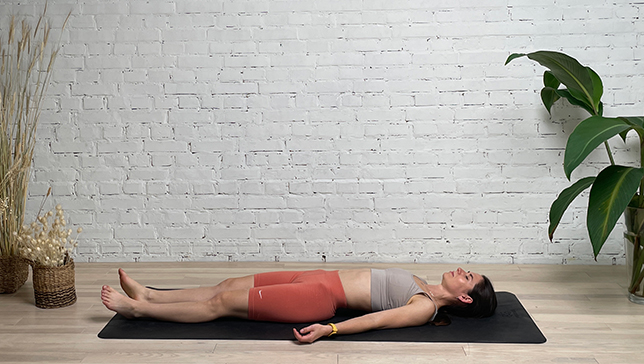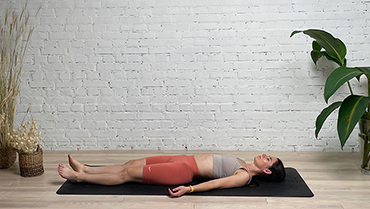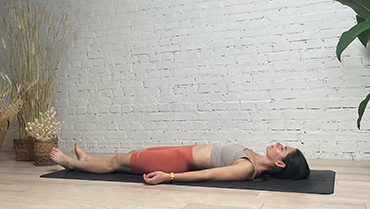Corpse Pose - Savasana

Contents
Verse 32 of the first chapter of the Hatha Yoga Pradipika states: ‘Lying upon one’s back on the ground at the full length like a corpse is called Savasana. This removes the fatigue caused by the other yoga poses and induces calmness of mind’. In Sanskrit ‘Sava’ means ‘corpse’ and ‘asana’ means ‘pose’ thus the name of the pose in English is Corpse Pose.
In Corpse Yoga Pose, the objective is to imitate a corpse by keeping the body still. By remaining motionless for some time and keeping the mind still while you are fully conscious, you learn to relax. This conscious relaxation invigorates and refreshes both body and mind.
This apparently easy posture is one of the most difficult to master, irrespective of the level of yoga practice or body flexibility.
Pose Detail
- Difficulty: Beginners
- By Type: Meditation Yoga Poses, Restorative Yoga Poses
- Body Position: Supine Yoga Poses
- By Benefit: Yoga Poses For Anxiety And Panic Attack, Yoga Poses For Stress Relief
Step-by-Step Instructions
Benefits and Contraindications
Calms the brain and helps relieve stress and mild depression
Reduces headache, fatigue, and insomnia
Relaxes the body
Helps to lower blood pressure
Back injury or discomfort: Do this pose with your knees bent and your feet on the floor, hip-distance apart; either bind the thighs parallel to each other with a strap (taking care not to position the heels too close to the buttocks) or support the bent knees on a bolster.
Pregnancy: Raise your head and chest on a bolster.
Photo poses in different angles


Modifications and Props
Here are some ways to modify savasana with props:
- Use a bolster: Place a bolster (a long, firm cushion) lengthwise on your mat and lie back on it so that it supports your entire spine. This can be especially helpful if you have lower back pain or discomfort. You can also place a rolled-up blanket or towel under your knees for added support.
- Place a blanket over the eyes: Covering your eyes with a soft blanket or eye pillow can help to further relax the mind and reduce any light sensitivity.
- Use a sandbag: Placing a sandbag over your belly can provide a grounding and calming sensation.
Useful Tips
Teachers often say that Savasana is the most difficult yoga pose, which is really a way of saying that it’s really hard for some people to do nothing for 10 minutes. If you find it challenging, try scanning your body from toe to head, saying the name of each body part, and then releasing it. Your body needs this time to absorb the new information it has received through physical practice.
Often, the mind wants to stay active even when the body is relaxed. Your mind might have been calm during your pose sequence, but now you need to develop that same calmness when at rest. If your mind won’t stop chattering, try the basic meditation techniques of noticing your thoughts, labeling them as thinking, and then letting them go. Just like other types of yoga, this takes practice.
Eventually, you will notice that when your body goes into Savasana, your mind also assumes a relaxed state.
Frequently Asked Questions
Savasana can be held for anywhere from 5-20 minutes, depending on your personal preference and the length of your yoga practice. The goal is to allow your body and mind to fully relax, so listen to your body and stay as long as you need.
While Savasana is traditionally done at the end of a yoga practice, it is ultimately up to you whether or not you want to include it in your practice. However, it is considered an important part of the practice and can help to reduce stress and anxiety, so it is recommended to give it a try.
It is not uncommon to fall asleep during Savasana as the body and mind are deeply relaxed. If you fall asleep, that is perfectly okay! Just try to bring your awareness back to your breath and your body when you wake up.
Yes! Props such as blankets, bolsters, and blocks can be used to make Savasana more comfortable and accessible for different bodies. Experiment with different props to find what works best for you.
Yes, Savasana can be a great time to practice meditation. Focus on your breath or repeat a mantra or intention to help calm the mind and deepen your relaxation.
Yes, Savasana can be practiced during pregnancy, but it may require some modifications. As your pregnancy progresses, lying flat on your back can cause discomfort or decrease blood flow to the uterus. Here are some modifications to practice Savasana during pregnancy:
- Use props: Use pillows, bolsters or blankets to elevate your upper body and head. This will create a slight incline, which is more comfortable for most pregnant women.
-
Use the side-lying position: Lie on your left side with a pillow or bolster between your legs and a pillow or blanket to support your head and neck.
-
Use a chair: Sit in a comfortable chair with your feet flat on the ground and your back supported by the chair. Use a pillow or blanket to support your head and neck.
-
Practice guided relaxation: Instead of lying down, you can practice deep relaxation in a seated or reclined position. Listen to a guided relaxation meditation or visualization to help you relax deeply.
Snoring during Savasana can be caused by a few different factors.
First, Savasana is a deeply relaxing pose, and it’s not uncommon for people to fall asleep or enter a deep state of relaxation. When you are deeply relaxed, the muscles in your throat and airway can become more relaxed as well, which can lead to snoring.
Secondly, snoring can be caused by a blocked or narrow airway, which can be exacerbated by lying on your back. If you are prone to snoring, try elevating your head slightly with a pillow or blanket or trying a different position such as side-lying.
Lastly, snoring can be caused by other factors such as allergies or nasal congestion. If you are experiencing snoring during Savasana or at other times, it may be helpful to talk to your healthcare provider to rule out any underlying medical conditions or to seek treatment for allergies or congestion.
Overall, snoring during Savasana is not uncommon and is usually not a cause for concern. However, if it is interfering with your practice or causing discomfort for others around you, it may be helpful to try different modifications or seek treatment for any underlying causes.
Variations
- Pentacle Pose
- Reclined Bound Angle Pose (Supta Baddha Konasana) Savasana
- Legs up the Wall (Viparita Karani) Savasana
- Side Lying Corpse Pose
- Dynamic Savasana
Top Preparatory Poses
Top Follow-Up Poses
- Wind Relieving Pose
- Side Lying Corpse Pose
- Easy Pose